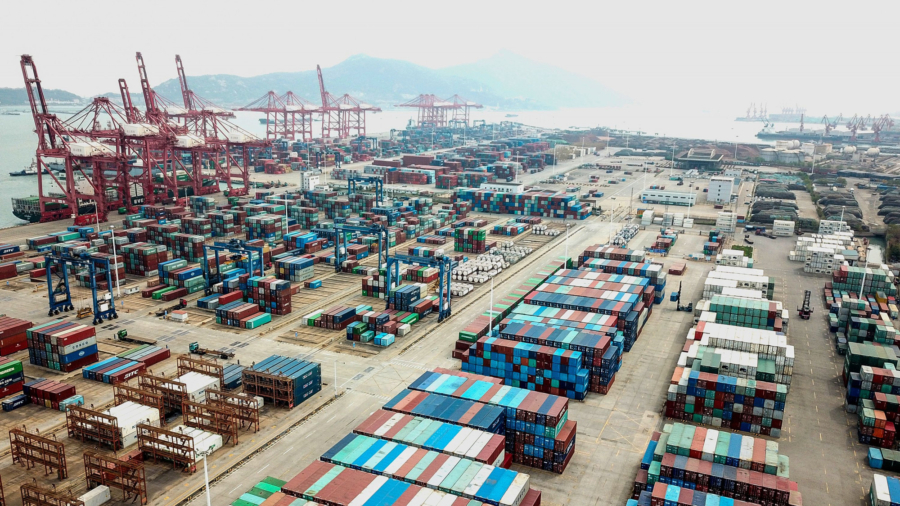WASHINGTON—The Trump administration is “turbocharging” an initiative to remove global industrial supply chains from China as it weighs new tariffs to punish Beijing for its handling of the CCP virus outbreak, according to officials familiar with U.S. planning.
President Donald Trump, who has stepped up criticisms of the Chinese regime amid the pandemic, has long pledged to bring manufacturing back from overseas.
Now, economic destruction and the massive virus death toll are driving a government-wide push to move U.S. production and supply chain dependency away from China, even if it goes to other more friendly nations instead, current and former senior U.S. administration officials said.
“We’ve been working on [reducing the reliance of our supply chains in China] over the last few years but we are now turbo-charging that initiative,” Keith Krach, undersecretary for Economic Growth, Energy and the Environment at the U.S. State Department, told Reuters.
“I think it is essential to understand where the critical areas are and where critical bottlenecks exist,” Krach said, adding that the matter was key to U.S. security and one the government could announce new action on soon.
The U.S. Commerce Department, State Department, and other agencies are looking for ways to push companies to move both sourcing and manufacturing out of China. Tax incentives and potential re-shoring subsidies are among measures being considered to spur changes, the current and former officials told Reuters.
“There is a whole of government push on this,” said one. Agencies are probing which manufacturing should be deemed “essential” and how to produce these goods outside of China.
Trump’s China policy has been defined by behind-the-scenes tussles between pro-trade advisers and China hawks; now the latter say their time has come.
“This moment is a perfect storm; the pandemic has crystallized all the worries that people have had about doing business with China,” said another senior U.S. official.
“All the money that people think they made by making deals with China before, now they’ve been eclipsed many fold by the economic damage” from the virus, the official said.
Economic Prosperity Network
Trump has said repeatedly that he could put new tariffs on top of the up to 25 percent tax on $370 billion in Chinese goods currently in place.
That does not mean Trump will balk at new ones, officials say. Other ways to punish China may include sanctions on officials or companies, and closer relations with Taiwan, the self-governing island that Beijing considers its territory.
But discussions about moving supply chains are concrete, robust, and multi-lateral, sources said.
The United States is pushing to create an alliance of “trusted partners” dubbed the “Economic Prosperity Network,” one official said. It would include companies and civil society groups operating under the same set of standards on everything from digital business, energy and infrastructure, to research, trade, education, and commerce, he said.
The U.S. government is working with Australia, India, Japan, New Zealand, South Korea, and Vietnam to “move the global economy forward,” Secretary of State Mike Pompeo said April 29.
These discussions include “how we restructure … supply chains to prevent something like this from ever happening again,” Pompeo said.
Latin America may play a role, too.
Colombian Ambassador Francisco Santos last month said he was in discussions with the White House, National Security Council, U.S. Treasury Department, and U.S. Chamber of Commerce about a drive to encourage U.S. companies to move some supply chains out of China and bring them closer to home.
China overtook the United States as the world’s top manufacturing country in 2010, and was responsible for 28 percent of global output in 2018, according to United Nations data.
The pandemic has highlighted China’s key role in the supply chain for generic drugs that account for the majority of prescriptions in the United States. It has also shown China’s dominance in goods like the thermal cameras needed to test workers for fevers.
Some Companies Reluctant
Many U.S. companies have invested heavily in Chinese manufacturing and rely on China’s 1.4 billion people for a big chunk of their sales.
“Diversification and some redundancy in supply chains will make sense given the level of risk that the pandemic has uncovered,” said Doug Barry, spokesman for the U.S.-China Business Council. “But we don’t see a wholesale rush for the exits by companies doing business in China.”
John Murphy, senior vice president for international policy at the U.S. Chamber of Commerce, said that U.S. manufacturers already meet 70 percent of current pharmaceutical demand.
Building new facilities in the United States could take five to eight years, he said. “We’re concerned that officials need to get the right fact sets before they start looking at alternatives,” Murphy said.
By Humeyra Pamuk and Andrea Shalal
NTD staff contributed to this report.

